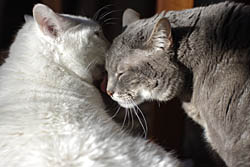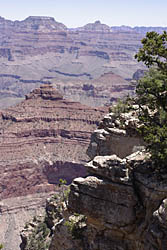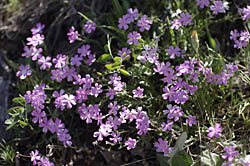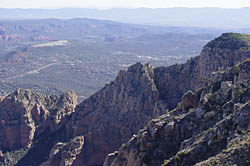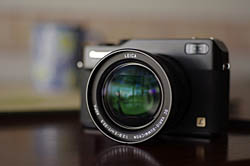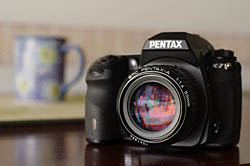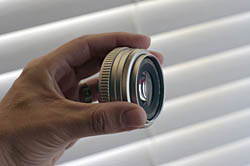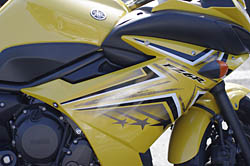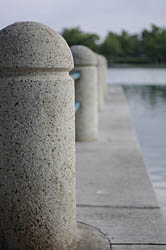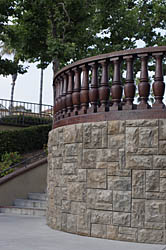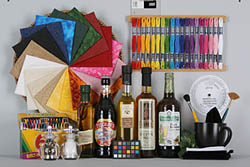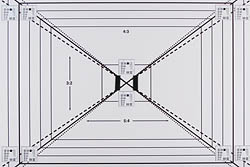| 43mm |
$597 average price |
|---|---|
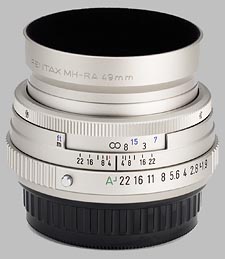
|
|
Your purchases support this site
Pentax K - Black
Pentax 43mm f/1.9 Review
by Andrew Alexander and Carl Garrard
Updates:
03/18/2008: Lab Test posted
09/28/2010: Field Test and Gallery Images posted
The Pentax limited edition lenses show off a polish and refinement you don't see in average lenses. From the first moment you mount the 43mm ƒ/1.9 you can tell it's been manufactured with an eye to detail.
With a 35mm image circle, the 43mm is fully backward-compatible with all Pentax K-mount film bodies. On a subframe sensor body, the lens will give an effective field of view of around 65mm, a very unusual focal length. It's quite light for its construction, and makes a very compact camera package when mounted to a Pentax body. It takes 49mm filters, and is available for under $600.
Pentax 43mm f/1.9 Field Test
by Carl Garrard | September 28, 2010
Introduction. Lab results provide a very important and unbiased report on how a lens performs. They are a good starting point when deciding whether or not to purchase a lens, as you can get a good idea of how the lens is going to perform. However, in my experience, I've found that there is the hands-on experience is very important when choosing lenses for your DSLR system.
Using a lens in the field will tell you more about how you the photographer will bond with a particular lens and how it will ultimately fit into your shooting routines. Sometimes lab results alone won't keep your wallet from emptying if you like how a lens feels in your hand, if you like its weight and size, how it looks on your DSLR, and lastly if you are happy with the results you see from the lens on your screen or in print. This is the real-world equation that I attempt to explore in this review, and hopefully communicate to the reader.
Technical Overview. The SMC Pentax FA 43mm ƒ/1.9 Limited lens is a fixed focal length pancake lens that lies in the middle of the focal range among Pentax’s extensive lineup of compact prime lenses. At 43mm (roughly 65mm equivalent on APS-C) the little Pentax is neither wide angle nor telephoto lens, and can basically be considered a standard lens. The original, silver version of the lens is made in Japan but newer (black) models are now assembled in Vietnam; this does not seem to have affected quality in the slightest.
I tested the 43mm Limited lens on my own personal Pentax Kx and Pentax K7 DSLRs.
Lab Notes. Readers should be aware that I did not look at the lab results until after I was done testing and using this lens in the field. I was rather excited and curious to see how my impressions would compare to the technical aspects of testing in the lab, and how closely my impressions were to those results practically. I report later here about my experiences in the field with this lens and how they compare to the following results from the lab. According to the lab results, the Pentax 43mm Limited is a stellar performer with very few weaknesses; those would include significant chromatic aberration and being soft wide open at ƒ/1.9. It also has a less-than-average maximum magnification ratio.
Size and Appearance. The size of the Pentax 43mm Limited overall can best be described as petite, but not miniscule. They don't call this lens a pancake lens for nothing, but it's still not as small as the near legendary 40mm Pancake that Pentax also offers.
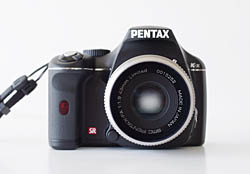 |
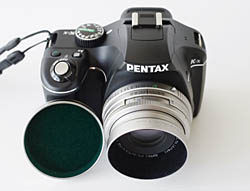 |
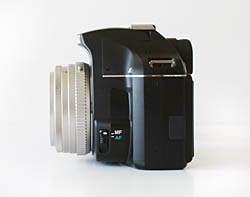 |
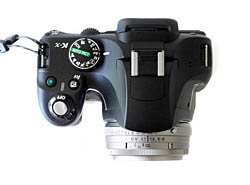 |
This lens is gorgeous; lens manufacturers really don't make them look much nicer than this. Fit to my K7 or K-x, the 43mm ƒ/1.9 looked equally at home, and in some way outshines both cameras, making you wish for a matching camera body. There are enough silver accents on the black K-x that it seems to match nicely enough, and looks great on your camera.
Build Quality. The little Pentax lens is made completely from metal and glass, and feels dense and quite well-built. There are few modern lenses built today of this caliber, but Pentax seems to have a habit of making well-built small prime lenses. The 43mm Limited is no exception, and perhaps one of the finer lenses you can buy today.
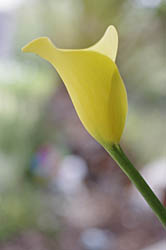 |
Bokeh. With regard to bokeh, I found the 43mm to be a bit "busy", with its middle-of-the-road focal length contributing to the out-of-focus effects. When focused at the minimum focus distance and shooting at f/2.8, the rather busy bokeh seems to tame a bit (in terms of bright halos on defocused bright points), and smooths out a bit more. Even then, I wouldn't refer to the 43mm LTD as a bokeh tool. It does however do a very good job and better than some other lenses that don't shoot as wide open.
Sharpness. For distant subjects, the 43mm Limited offers excellent sharpness, picking up the finest details. If you can live with the focal range, the 43mm can produce tack sharp landscape photographs, or near-perfect documentary photography where every single detail is needed. Even wide open there's not much to complain about here at all with at least 80% of the image in the center being sharp enough to satisfy even the most demanding pixel peeper. Optimum sharpness I found to be around f/5.6, which wasn't all that much sharper than f/2.8.
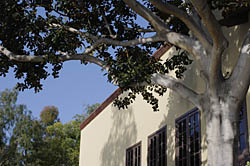 |
Contrast. The Pentax 43mm ƒ/1.9 offers very good contrast without being overbearing. Sure, we can adjust contrast in-camera or during post-processing, but lenses do have variations in how they render contrast. The Pentax 43mm lens produces images with contrast similar to those produced by Zeiss but it keeps a bit of a softer overall contrast performance that I prefer and find a bit more natural. Even wide-open at ƒ/1.9, contrast is better than most lenses with large apertures, which is testament to its quality optics. Contrast is optimum at f/5.6.
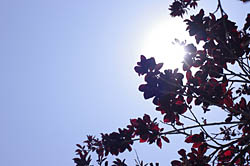 |
Ghosting and Flare. I found no evidence of ghosting (sensor reflection on the rear element) in any of my images. Flare performance is actually so good that I find the use of the included lens hood to be a moot point, unless of course you want to add extra protection to your investment. There is some flare evident in the most extreme circumstances, but overall it is pretty minimal in comparison to many lenses I've used. I like to include flare in some of my images as an artistic touch for specific circumstances sometimes anyway, so a little flare is good to have. Even in the most extreme circumstances (image left) the little Pentax held up well.
Macro Performance. A weakness with this lens is the minimum focusing distance area and macro performance. With its 0.12x magnification specification, this translates into a minimum captured area of just over seven inches wide. Using this lens for flower portraiture or small objects isn't its strong suit, so I would not reach for this lens for this type of shooting. A 2x Macro lens attached to the front would give this lens much more versatility. Other lens makers include them, such as Zeiss and Voightlander on some of their lenses, and this little Pentax would benefit from one much the same.
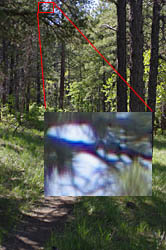 |
Chromatic Aberration. Chromatic aberration was noticeable on a computer monitor. Overall, however, it wasn't problematic enough for me to consider removing it in post-processing. I've seen worse results and not all C.A. is the same: Some is very difficult to remove, with hard edges and multiple hues that bleed into your subjects, making removal without image degradation nearly impossible. Not so with the 43mm Limited. The chromatic aberration that was objectionable was removed easily enough in post-processing. I noticed that C.A. really didn't show up much when the lens was stopped down to f/4 and beyond. Considering this is one of the more stand-out lab weaknesses of this lens, I find it interesting that it wasn't all that problematic for me in real-world use. To see the chromatic aberration in the image to the left, zoom in on the top of the pine trees. The image was captured at f/2.8.
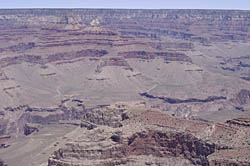 |
Geometric Distortion. The Pentax 43mm ƒ/1.9 produces no significant geometric distortion. This coincides with the lab findings where only a trace amount of barrel distortion could be found. A great performer, and peace of mind to the time-conserving photographer who doesn't want to correct for geometric distortion later on. As you can see in the image of the Grand Canyon, the horizon shows very little barrel distortion.
Color Response. Regarding its color reproduction, the Pentax 43mm LTD is quite neutral in color rendering: It casts neither a warm or cool tone to the images, which is just how I prefer a lens to perform. Color is much easier to manage digitally than it is for film, but it is rather nice that the lens start with an accurate color rendering like the little Pentax does. It's one of the more pleasing performance characteristics of this lens that helped me to warm up to it.
Alternatives. If I were to pick one single prime for my DSLR outfit, I'd prefer the 35mm LTD macro or an inexpensive 50mm f/1.4 SMC Pentax-A from the used market (which I also own). However, the Pentax 43mm ƒ/1.9 LTD is a lens that would go well with the 15mm LTD or 77mm LTD lenses. Those three lenses could cover quite a range and not weigh heavily on your bag (only perhaps your wallet). This is the scenario in which I find myself wanting the 43mm LTD, as part of a collection. The 43mm LTD has the heritage, allure, and build to last a long time, perhaps a lens that I'd want to pass on to my son, and that he'd one day pass on to his.
Who's it for? Journalists and street photographers would probably like this lens. Outdoor enthusiasts will appreciate its low weight and size; some may desire more field of view from the focal length on APS-C sensors, however (like me). The family man will appreciate its bright aperture for indoor shots of growing children, pets, and family functions, as well as bragging rights to having one of the nicest modern prime lens types from any camera manufacturer.
Summary. This report was obviously written on the silver 43mm Limited lens, which is difficult to find and quite expensive when you do. However, the black version is at least available and in stock with most retailers who carry Pentax. At the time of writing, it's available for between $560 and $650 online. This is quite a price to pay for a prime lens that doesn't seem to have any real stand-out strength, other than its physical characteristics and tack-sharp images. But if you want a small, lightweight, and stylish lens that doesn't suffer from geometric distortion and you aren't really picky about your focal length, this lens will make a nice addition to a Pentax prime collection in your bag.
Overall the SMC Pentax FA 43mm ƒ/1.9 Limited Lens is a well-built optic with only a few flaws. It has a decent all-around focal length that will handle most duties well, and won't weigh you down.
| Pros | Cons |
|
|
Gallery Images
Pentax 43mm f/1.9 Lab Test
by Andew Alexander | March 18, 2008
Sharpness
The 43mm ƒ/1.9 is a sharp lens, but only when you close the aperture down a few stops. Wide open at ƒ/1.9, significant softness can be found in the corner regions - the central third of the lens is fairly sharp at 1.5 blur units, but the corners hit upwards of 3 and 5 units. This softness reduces dramatically as the lens is stopped down to ƒ/2.8 and practically flattens out to an extremely sharp image at ƒ/4. Through ƒ/5.6 to ƒ/11 this sharpness trend is stable at 1.5 units, with diffraction limiting creeping in at ƒ/16. Even fully stopped down at ƒ/22, the lens is impressively sharp at a uniform 2 blur units.
So if you want your images to be uniformly sharp, this isn't a lens to be used wide open; by ƒ/2.8 you should get acceptably sharp results, with the best results showing up at ƒ/4 and above.
Chromatic Aberration
The lens has an issue with chromatic aberration, showing a relatively high average value of approximately 5/100ths of a percent of frame height at all apertures, and a maximum value of approximately 9/100ths. The chromatic aberration isn't the worst we've seen, but is noticeable enough in the corners to warrant comment.
Shading (''Vignetting'')
Corner shading isn't a problem with this lens - only a third of a stop darker in the corners when the lens is set to anything below ƒ/2.8. By ƒ/2.8 and above, corner shading is negligible.
Distortion
Distortion is also a non-factor with the 43mm ƒ/1.9, tending towards negligible barrel distortion (0.25% maximum, 0.125% average). These values are so small as to be almost negligible, and if it's vital to have your straight lines absolutely straight, the distortion isn't complex and can be easily corrected with image post-processing software.
Autofocus Operation
The 43mm lens is mechanically driven, producing slower focusing results. A full rack through the focus is completed in 1.5 seconds on a K100 Super body, and produces a noticeable higher-pitched motor noise. Point-to-point focusing is not noticeably faster or quieter.
Macro
The lens is not a dedicated macro lens, with a maximum magnification of 0.12x and a close-focus distance of 45cm (just under 18 inches).
Build Quality and Handling
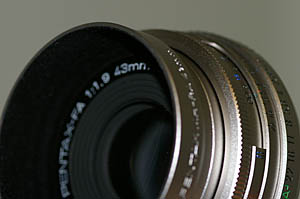 Pentax limited edition lenses are extremely solid and durable lenses, and the 43mm ƒ/1.9 is no exception. The lens is solid metal, our version being a silver model that feels like a precision-crafted device. Being silver, It does look a little out of place on the all-black K100 Super body.
Pentax limited edition lenses are extremely solid and durable lenses, and the 43mm ƒ/1.9 is no exception. The lens is solid metal, our version being a silver model that feels like a precision-crafted device. Being silver, It does look a little out of place on the all-black K100 Super body.
 The 43mm ƒ/1.9 is equipped with an aperture ring, a recessed distance scale and a depth-of-field indicator with infrared index. It doesn't have Pentax's ''quick-shift'' autofocus technology, meaning the focus is locked in place when set to autofocus and can only be turned when the body is set to manual focus operation. There is no autofocus/manual focus selector on the lens.
The 43mm ƒ/1.9 is equipped with an aperture ring, a recessed distance scale and a depth-of-field indicator with infrared index. It doesn't have Pentax's ''quick-shift'' autofocus technology, meaning the focus is locked in place when set to autofocus and can only be turned when the body is set to manual focus operation. There is no autofocus/manual focus selector on the lens.
There's no denying the slick finishing touches inherent in the lens; even the lens cap is lined with green velvet for a classy and protective touch. The cap 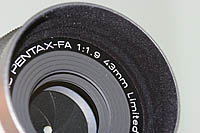 slides over the removable lens hood (also lined with velvet - black velvet). The lens accepts 49mm filters, though you'd need to remove the lens hood first and attach it onto the applied filter. As you might expect, any attached filters won't rotate during focus operation.
slides over the removable lens hood (also lined with velvet - black velvet). The lens accepts 49mm filters, though you'd need to remove the lens hood first and attach it onto the applied filter. As you might expect, any attached filters won't rotate during focus operation.
Alternatives
Being a fairly specific lens, there aren't direct comparisons to be made (no one else makes a 43mm ƒ/1.9 lens). However, there are a few options in the same ball park.
Pentax 40mm ƒ/2.8 Limited SMC P-DA ~$290
Another limited edition lens, the 40mm ƒ/2.8 ''pancake'' lens is probably as small and light as they come, with exceptional results for all of sharpness, chromatic aberration resistance, vignetting and distortion. Unless you really need an extra stop of light-gathering ability, or like a little softness in your corners when shooting wide open, the cheaper price tag and smaller size makes this a highly competitive alternative; however, it is designed with APS-C digital SLR bodies in mind, not having an aperture ring. However, the lens shows no signs of vignetting on a full 35mm frame.
Pentax 50mm ƒ/1.4 SMC P-FA ~$200
We haven't tested the Pentax 50mm, but it's also a full frame lens with an aperture ring which takes 49mm filters. It weighs slightly more, but costs slightly less, and is a half-stop faster.
Conclusion
There's no denying the sex appeal of the silver 43mm ƒ/1.9 - it almost evokes a feeling of nostalgia for bygone days of manual film cameras. It looks good, and performs well enough to buy as a walkaround lens that acts as a slightly-longer-than 50mm when mounted on a dSLR. I could have done with a more advanced focus system; oddly enough the smaller 40mm ƒ/2.8 pancake lens focuses faster and quieter, and is equipped with Pentax's ''quick-shift'' system to allow manual override of the autofocus at any time. Optically, it's better than average but not extraordinary: chromatic aberration is slightly pronounced, and corner softness is an issue when shooting wide open. But if you're into that look, and want to look good while getting it, then this is the lens for you.
Sample Photos
The VFA target should give you a good idea of sharpness in the center and corners, as well as some idea of the extent of barrel or pincushion distortion and chromatic aberration, while the Still Life subject may help in judging contrast and color. We shoot both images using the default JPEG settings and manual white balance of our test bodies, so the images should be quite consistent from lens to lens.
As appropriate, we shoot these with both full-frame and sub-frame bodies, at a range of focal lengths, and at both maximum aperture and ƒ/8. For the ''VFA'' target (the viewfinder accuracy target from Imaging Resource), we also provide sample crops from the center and upper-left corner of each shot, so you can quickly get a sense of relative sharpness, without having to download and inspect the full-res images. To avoid space limitations with the layout of our review pages, indexes to the test shots launch in separate windows.
Pentax 43mm f/1.9 Limited SMC P-FA
Your purchases support this site
Pentax K - Black
Pentax 43mm f/1.9 Limited SMC P-FA User Reviews
-
excelenent contrast and bokehlittle bit of CA
This lens is absolute gem.
reviewed November 17th, 2009
I have both FA50 and FA35 and I was eager to see what will the FA43 be like.
It leaves the FA50 in dust and even has a bit edge of appeal against the FA35.
I already tried quite a lot of lenses with both Pentax and Canon systems, but never experienced the wow effect of FA43 before. The contrast it puts into slightest details of the image is unbelievable.
The CA is easier to correct than with other primes (such as FA50) and no problem at all.
And above all the Fa43 is a pleasure to use, it is more than just a great lens. It is a great lens with built quality to survive decades and still look like a jewel. -
looks, image quility, build, size
was hooked onto this lens due to its looks first time I saw it.
reviewed November 15th, 2006 (purchased for $470)
a real charmer to use.
fast and extremely sharp.
smoth operation.
all metal construction superbly built.
extremly small.
focus ring is a bit small may be a bit tricky if you have a large hand.
Excelent buy. -
the lens is next to perfectnone
Well where to start, bought this lens as a walkabout lens, and because I wanted a fast lens when indoor situations demanded it.
reviewed September 29th, 2006 (purchased for $400)
I have so far not been disappointed. This lens is among the best I have seen.
Crisp, excellent bokeh, fast and razor sharp.
Even a very smooth manual focus.
THe build quality is a chapter of its own. Outstanding, simply outstanding.
Aluminium all the way and the short full cone hood is linned with black felt. Lens cap is in aluminium as well and linned with a fine green felt that keeps the cap attached to the hood. very smooth.
I have acheaved excellent portraits and beautiful landscape photos with this one.
It has my strongest recommendation, excellent performance in every aspect and the it is a beauty on the camera:)




